Fantasia 2018, Day 10, Part 1: The Travelling Cat Chronicles and Da Hu Fa
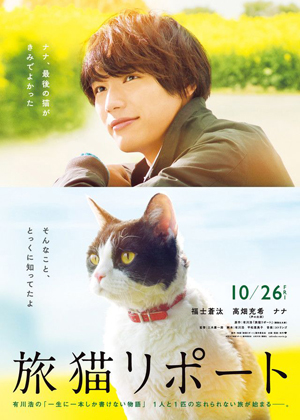 I had three screenings I planned to attend at Fantasia on Saturday, July 21. The last would be a showcase of short films, but the first two were features. The day would begin at the Hall Theatre with The Travelling Cat Chronicles, an adaptation of a Japanese novel about a cat and assorted humans. Then would come Da Hu Fa, a 3D animated film from China about a diminutive martial-arts master seeking a lost prince within a hidden valley.
I had three screenings I planned to attend at Fantasia on Saturday, July 21. The last would be a showcase of short films, but the first two were features. The day would begin at the Hall Theatre with The Travelling Cat Chronicles, an adaptation of a Japanese novel about a cat and assorted humans. Then would come Da Hu Fa, a 3D animated film from China about a diminutive martial-arts master seeking a lost prince within a hidden valley.
The Travelling Cat Chronicles (Tabineko ripôto, 旅猫リポート) was directed by Koichiro Miki from a script by Emiko Hiramatsu adapting Hiro Arikawa’s novel. Nana is the travelling cat in question, and she narrates the film in question (voice-work contrbuted by Mitsuki Takahata) as Satoru (Sota Fukushi, also in Laplace’s Witch, the Library Wars movies, and Blade of the Immortal), her human, tries to find her a new home. The reason why Satoru must find a new home for his beloved cat isn’t hard to realise, but at least at first the point is that he takes Nana with him as he travels around to some of his closest friends — all of whom are willing to take her in, but each of whom have various practical difficulties. Flashbacks establish Satoru’s relationships, and his travels with Nana become a way into his life as a whole, leading to some surprising revelations and to a devastating emotional conclusion.
The first thing that has to be said about this movie is that it’s the most ruthlessly effective tearjerker I’ve ever seen. The entire second half of the movie played over a theatre full of sniffles and sobs. I thought at first that I’d never heard so much crying at a Fantasia film, then revised that to “any film,” and by the end to “any gathering, funerals and memorials included.” If it’s a tearjerker, though, it’s a tearjerker with real integrity — it’s so effective in large part because it’s a good dramatic film, not because it’s filled with unearned emotion. (I will specifically note that nothing too bad happens to Nana.)
It’s also effective because every character in the movie is genuinely nice. You sympathise with all of them; you see why they do what they do. And what tragedies of their own they have to cope with. Most notably, a character we barely meet, the father of Satoru’s best friend Kosuke (Ryosuke Yamamoto) at first is described as cruel and abusive, but with a few lines here and there and one twist near the end we come to understand him better, come to see for whatever damage he’s inflicted he’s really a man who simply doesn’t understand people. It’s impressive when a film’s able to humanise a character who barely appears in more than a few frames.
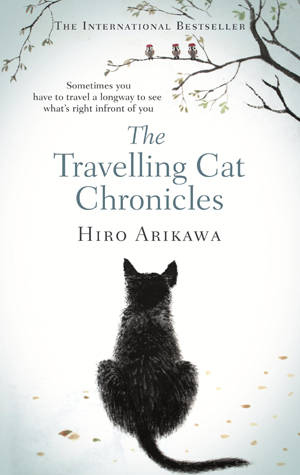 Conversely, as a lead, Satoru is charismatic, smiling, always happy; and yet a revelation that there’s more to him emotionally than is at first obvious isn’t really surprising. It’s an excellent performance by Fukushi. There’s just enough falsity in Satoru that he’s feels credible, and then as we find out more about what is false and why he grows only more sympathetic. (As I say, it’s not hard to guess what’s really going on. I don’t want to give that away here, but I will note that it comes out indirectly in an argument between Nana and a dog that thinks he’s trying to protect his masters; the use of Nana’s voice-over makes perfect sense if only for this one moment.)
Conversely, as a lead, Satoru is charismatic, smiling, always happy; and yet a revelation that there’s more to him emotionally than is at first obvious isn’t really surprising. It’s an excellent performance by Fukushi. There’s just enough falsity in Satoru that he’s feels credible, and then as we find out more about what is false and why he grows only more sympathetic. (As I say, it’s not hard to guess what’s really going on. I don’t want to give that away here, but I will note that it comes out indirectly in an argument between Nana and a dog that thinks he’s trying to protect his masters; the use of Nana’s voice-over makes perfect sense if only for this one moment.)
As this all might imply, the plot’s extremely tight. There’s a revelation about Satoru’s past near the end that’s arguably overwrought — but it does echo aspects of his life, specifically his taking-in of cats. It’s a plot point that has to do with kindness for other living things, and the way that kindness is an instinct, if we let it be. This is a film concerned with the bonds between people, of both the two-footed and four-footed kind, and there’s not a single foot of any kind set wrong here. There’s a moment in a flashback where Satoru’s overwhelmed by grief; one person, and only one, steps forward to comfort him; and that introduction of a character, Satoru’s aunt Noriko (Yuko Takeuchi, Sherlock in Miss Sherlock) not only sets up who Noriko is through her act of kindness, it sets up the role she plays in Satoru’s life, and by extension also sets up the end of the film.
(Incidentally, after seeing films on each of the prior two days in which flashbacks tended to vitiate dramatic action, it’s worth pointing out that flashbacks here are used perfectly. They’re interjected at the right time, they include vital plot and character information, and they each have their own feel. They’re also balanced in terms of length and structure in the script. Again here the overall shape of the story is perfectly worked.)
It also establishes her relationship to Satoru, and in a sense that’s what the film’s about: Satoru’s relationships. By extension, it’s about the way we all relate to others. I don’t know that it says much that is new or surprising, but it is an affirmation of kindness, and that’s always important when it’s done well. Which it is, here. It’s shot well (a lovely pair of images of a cat on a rooftop bookend the movie), performed well, and written with an exquisite sense of structure. The characters come alive and so draw us in. The world here is, ultimately, one we recognise; one in which tragedy happens, is unavoidable, but can be sometimes mitigated by the kindness of others. This is an intensely realist film, Nana’s voice aside; and even that is less of an element of the film than one might imagine.
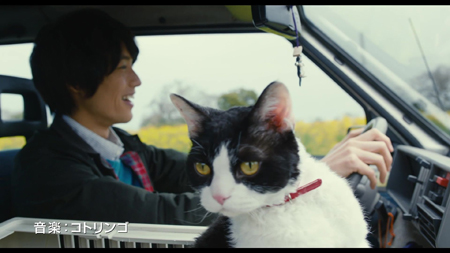 Still, if the use of Nana’s narration is perhaps slightly underplayed, it grows in importance through the movie. By the end the film’s a tribute to her loyalty which for obvious reasons I cannot call ‘dogged’ but which, improbable or not, seems to embody the real emotional bonds that can come to exist between humans and non-humans who become adopted into their families. Cats here are characters, but also symbols: they’re a part of life, a part of human life, and represent a period in a human’s life. They’re an example of the bonds between people, a deep familial relation that comes about by choice and that can come to mean more than almost anything. The emotional resonance is obvious. The Travelling Cat Chronicles succeeds because it’s explored with precision, taste, and warmth.
Still, if the use of Nana’s narration is perhaps slightly underplayed, it grows in importance through the movie. By the end the film’s a tribute to her loyalty which for obvious reasons I cannot call ‘dogged’ but which, improbable or not, seems to embody the real emotional bonds that can come to exist between humans and non-humans who become adopted into their families. Cats here are characters, but also symbols: they’re a part of life, a part of human life, and represent a period in a human’s life. They’re an example of the bonds between people, a deep familial relation that comes about by choice and that can come to mean more than almost anything. The emotional resonance is obvious. The Travelling Cat Chronicles succeeds because it’s explored with precision, taste, and warmth.
Da Hu Fa (大护法) was next, across the street at the J.A. De Sève Theatre. was written and directed by Busifan (the chosen pseudonym of Zhgang Yang). It’s the tale of Da Hu Fa (voiced by Xiao Liansha), a champion of the Kingdom of Yiwei, who comes to a mysterious valley in search of his kingdom’s missing Prince (Tutehameng). The portly Da Hu Fa — other characters consistently refer to or mock him as ‘fatty’ — finds a strange ecosystem within the valley, with humanoid drones, a massive floating black peanut, and various other forms of life all tied to each other in complex ways. He finds the Prince, convinces the Prince to return — and then the problems really begin, as the ruler of the valley is not eager to see them go.
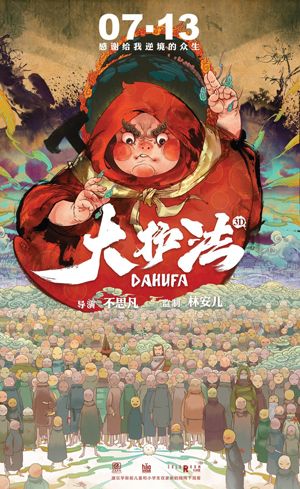 So far so good. Now here’s my problem: the subtitles I saw were terrible. Not just ungrammatical, they seemed to obscure what was happening in the film (I’ve heard that the subtitles were switched on Fantasia after the film was accepted at the festival). This is a problem in particular because I found the details of the valley’s social structure hard to parse. So this review should be read with the understanding that I only grasped a part of the movie.
So far so good. Now here’s my problem: the subtitles I saw were terrible. Not just ungrammatical, they seemed to obscure what was happening in the film (I’ve heard that the subtitles were switched on Fantasia after the film was accepted at the festival). This is a problem in particular because I found the details of the valley’s social structure hard to parse. So this review should be read with the understanding that I only grasped a part of the movie.
That said, the fact I’m able to write a review of the film at all is worth noting. The movie’s visual storytelling is remarkably strong, and indeed its design work and animation is very good. I could tell in general what was happening (I think), even if the details were often fuzzy. The outline of events was overall comprehensible: a first part of Da Hu Fa investigating the mysteries of the valley and finding the Prince, a second part of attempting to escape the valley, a third involving a major showdown among the various factions. The world is cartoony, no more detailed than it needs to be, with a lush colour sense. Watercolour effects give texture, allowing the third dimension to feel like it matters. I didn’t find the 3D effects particularly involving, but then I rarely do; and in fairness there is a lot of running and chase scenes that did seem to make use of the z-axis.
There might be a bit too many chase scenes; in the second half of the film they began to seem a bit repetitive. On the other hand, the pace of events was nicely varied. The characters felt underwritten, but here in particular I expect the subtitles play a part in my assessment. It is clear that the Prince has some obvious weaknesses along with a few rare virtues; Da Hu Fa, by contrast, feels relatively humourless.
The design sense is strong. Da Hu Fa’s an unusual-looking martial artist, a triangle of red that can burst into action with incredible rapidity. Smaller than almost everyone else, he seems overmatched until action begins; then we see how efficient he is, unsmiling and fierce. On the other hand, the easy grin of the Prince tells us what we need to know about his character at once. But the world of the valley, and the things we see there, are what make the film work. The detailed setting feels credible, and as the movie goes on, we realise how dark it actually is. The humanoids are not what they seem, with fake eyes and fake mouths. There is a plague, involving mushrooms that grow from their flesh. There are children in cages, and a security force that executes people at (seeming) random.
This is in fact a Chinese film about a society that is ruled despotically and teaches its people to submit to authority even when that authority is violent or murderous toward them. I note that the Communist Youth League has criticised the film as being “full of malicious political metaphors,” which implies a certain bravery in making and releasing it. I can’t claim to know how much or how pointed any social satire specific to China is. But I can say I think the idea of a passive, conformist society being misled by its leaders can be applied to any number of places and times.
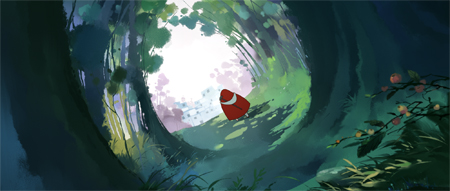 And it is possible to interpret the movie another way. Da Hu Fa is attempting to return a member of a royal family to his proper place. The process of doing this brings him into conflict with the unjust ruler of another state, and this conflict leads to a source of injustice being removed and the natural world being restored to a kind of harmony. This is not to say that there isn’t a kind of rebelliousness inherent in the movie — Da Hu Fa’s no respecter of persons, not even of his nominal royal family. But however much it has a specific application to Chinese politics, I think it also has the feel of a more general play of symbols.
And it is possible to interpret the movie another way. Da Hu Fa is attempting to return a member of a royal family to his proper place. The process of doing this brings him into conflict with the unjust ruler of another state, and this conflict leads to a source of injustice being removed and the natural world being restored to a kind of harmony. This is not to say that there isn’t a kind of rebelliousness inherent in the movie — Da Hu Fa’s no respecter of persons, not even of his nominal royal family. But however much it has a specific application to Chinese politics, I think it also has the feel of a more general play of symbols.
Again, though, it’s difficult to be sure of that given the state of the subtitles. I would very much like to see this film in a presentation when it made more sense. I can say that a certain amount comes across. How much more there is to get from it is impossible to judge. There is a lot that’s plainly impressive here. But I’d like to be able to write more extensively about it, from a fuller understanding of it. If I get the chance, I’ll revisit the film. As it stands, I’m reluctant to write more.
Find the rest of my Fantasia coverage here!
Matthew David Surridge is the author of “The Word of Azrael,” from Black Gate 14. You can buy his first collection of essays, looking at some fantasy novels of the twenty-first century, here. His second collection, looking at some fantasy from the twentieth century, is here. You can find him on Facebook, or follow his Twitter account, Fell_Gard.